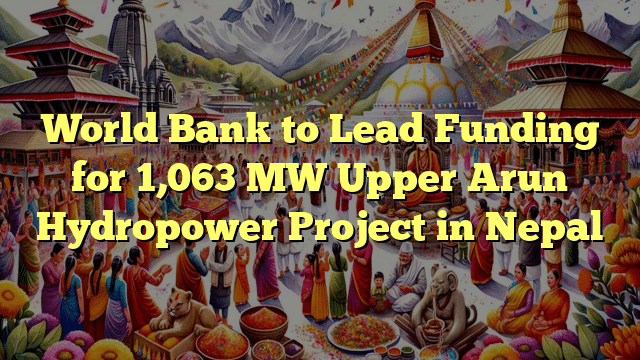
In a significant development, the World Bank has agreed “in principle” to spearhead the financing efforts for the ambitious 1,063 MW Upper Arun hydropower project in Sankhuwasabha, Nepal, announced the Finance Ministry on Friday.
The Upper Arun project, situated along the Arun River in eastern Nepal, is projected to require an investment of $1.71 billion.
The agreement comes on the heels of a meeting between Finance Minister Barsha Man Pun and Martin Raiser, Vice President of the World Bank for the South Asia region, in Washington DC, USA. Minister Pun is currently in the US to participate in the joint spring meeting of the World Bank and the International Monetary Fund.
Shree Krishna Nepal, Joint Secretary at the Finance Ministry, stated that the World Bank has provisionally agreed to lead the project, pending formal approval from the Cabinet.
“The forthcoming agreement will address financial management aspects with the World Bank,” said Nepal, who leads the International Economic Cooperation Coordination Division at the Finance Ministry.
The Cabinet’s decision in September 2018 laid the groundwork for the development of the project through Upper Arun Hydropower Limited, a subsidiary of the Nepal Electricity Authority. The survey license for the company was issued in September 2019.
With the feasibility study approved in June 2021, the project is slated for a construction period of 68 months.
The Upper Arun project holds promise as a pivotal venture among hydroelectric initiatives due to its cost-efficiency in generation and assured availability of substantial firm energy. It is expected to operate at full capacity for six hours daily during the dry season, surpassing the national average of four hours for hydropower projects in Nepal.
Nepal has been actively seeking approximately $1 billion in investments from the World Bank and other international financial institutions for the project, marking the global lender’s return to the Arun River basin after a hiatus of 28 years.
However, the World Bank’s contribution is anticipated to be around $550 million, as per Kul Man Ghising, Managing Director of the Nepal Electricity Authority.
The project’s financing structure is planned under a 70:30 debt-to-equity ratio, amounting to Rs150 billion in loans.
Key domestic financiers include the Hydroelectricity Investment and Development Company Limited, alongside Nepali banks and financial institutions.
A notable milestone was achieved in September 2022 when several entities, including the Nepal Electricity Authority, Upper Arun Hydroelectric Company, and the Hydroelectricity Investment and Development Company Limited, inked an investment agreement to secure domestic funding for the project.
The project aims to achieve financial closure imminently, paving the way for its development.
This marks the first instance of the World Bank’s direct funding for a hydropower project led by the Nepal Electricity Authority, signaling a potential boon for the country’s energy sector aspirations.
Efforts to mitigate past power shortages, exacerbated by the World Bank’s withdrawal from the Arun III project in 1995, have spurred renewed focus on hydropower initiatives. The current endeavor aligns with Nepal’s ambition to generate 30,000 MW of electricity by 2035.
Significant progress has been made on infrastructure fronts, including the commencement of tunnel and access road construction at the project site, alongside substantial advancements in land acquisition and compensation distribution.
The Upper Arun hydropower project aims to deliver an annual electricity output of 3.44 billion units, catering to both dry and wet seasons.
Related:



